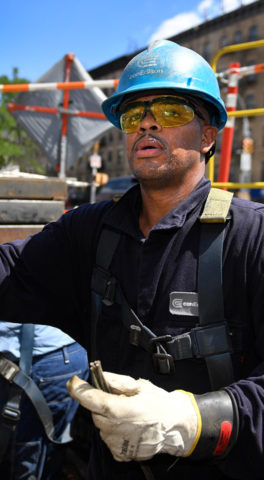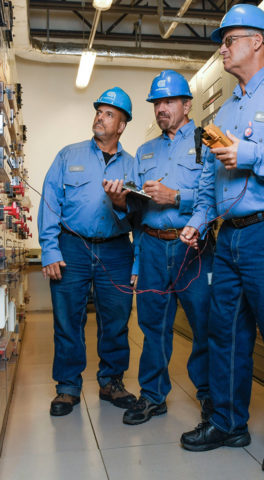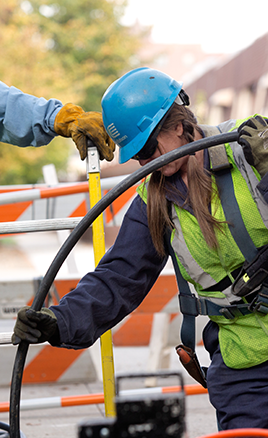
Operational Excellence
Core System Upgrades
The Advanced Meter Infrastructure (AMI) project is the largest project in company history. Approximately 5.3 million smart meters – comprised of roughly 3.9 million AMI electric meters and 1.4 million gas devices – will be deployed across our service territory and result in significant environmental, operational and customer benefits.
This project will actually put unprecedented control into the hands of Con Edison’s customers. With the company’s updated website and digital customer experience, customers can see their energy usage in near real-time and make smarter, more informed decisions about managing their energy usage, controlling costs and helping the environment.
The deployment of the communications network and smart meters is from 2017-2022, and began with the communications installation in Staten Island in January 2017. Since then, over 3,000 communications network devices have been installed throughout the company’s entire service area. In June 2017, a number of back office IT systems were placed into service in advance of AMI meter deployment, which began the following month in Staten Island and then in Westchester in October; meters were installed in Brooklyn and Manhattan in April and July 2018, respectively, totaling nearly 700,000 to date. The AMI Operations Center is currently staffed 24/7 to monitor the communications network as well as the meters and gas modules connected to the network.
In August 2017, Con Edison worked with the MTA in its emergent MTA signal meter circuits initiative and completed the installation of AMI meters and communications network devices in Brooklyn, Manhattan, Queens and the Bronx. We also created a monitoring dashboard providing insight into MTA signal power events, preventing outages before they occur; since November 2017, approximately 50 events have been mitigated.
The AMI project team has worked closely with Gas Operations and the AMI vendor to develop a first-of-its-kind, battery-powered natural gas detector that will be integrated with the AMI network. Con Edison plans to begin a pilot to install these sensors in the fourth quarter of 2018. The natural gas detectors are safety devices that monitor the air where Con Edison’s gas pipes enter our customers’ homes and buildings and provide an alert when natural gas levels in that area indicate a potential leak, which could become dangerous. The natural gas detectors will leverage the communications network, sending a wireless alert to Con Edison if a potential gas leak has been detected, allowing Con Edison and the fire department to respond quickly.
The AMI project will enable the company to operate the system at optimal voltages – conservation voltage optimization (CVO) – reducing total energy consumption as well as associated power generation emissions. Analysis shows the AMI system can be leveraged to reduce energy usage across our service territory by approximately 1.5% on average, decreasing associated fuel use for committed generation resources. This results in an environmental impact of 1.9% fewer total CO2 emissions due to reduction of power generated by fossil plants annually across our service territory and 1% total reductions in NYS. AMI will be providing engineers and planners with more granular data, enabling potential design and operational improvements. Con Edison is targeting to begin implementing CVO in Staten Island by the end of 2018.
CECONY invested $1.5 billion in its transmission and distribution systems in New York City and Westchester County to prepare for summer 2018. The investment included upgrades and reinforcements of 18 network transformers and 74 overhead transformers; the company also upgraded 37 underground feeder sections and 136 overhead spans.
Con Edison projected that peak demand for electricity in the summer of 2018 would reach 13,300 megawatts – the actual peak summer demand was 12,766 megawatts, on Sept 6, 2018. (The record is 13,322 megawatts, which occurred at 5 p.m. on July 19, 2013.) The company is always exploring new ways to keep service reliable. Con Edison has installed 1,000 devices in manholes to detect heat and gas in underground structures and communicate this information back to the control room. By remotely monitoring these conditions, the company is advancing towards making preemptive repairs prior to a cable failure. In addition, Con Edison is using infrared imaging across the system to identify and repair hot spots in cable and connections that are not visible to the human eye.
Electric Transmission Pipe Enhancement

We are investing $47 million for the refurbishment of 8,400 trench feet of leak-prone pipe in 2018, and refurbished 7,737 trench feet of piping in 2017. We invested $5 million in spill remediation efforts to improve the environment. We expect to make significant progress in research and development to reduce the potential for future oil spills. We’re also investing in research and development that can replace existing oil-filled feeders with solid dielectric cable.
Our underground transmission system consists of 660 miles of 69, 138, and 345 kilovolt feeders encased in steel pipe surrounded by high-pressure dielectric fluid (a non-toxic synthetic compound similar to mineral oil). The conductors inside our steel pipes are wrapped in paper insulation, impregnated and pressurized by the dielectric fluid at a nominal pressure of 200 pounds per square inch. In some feeders the dielectric fluid is circulated and cooled to provide enhanced current-carrying capability. Approximately nine million gallons of dielectric fluid is contained within the feeders, the pressurization plants, and the cooling plants.
Our leak-detection methods are some of the most sophisticated in the world:
- We use real-time monitoring of some of the largest volume feeders to constantly check their integrity.
- We infuse our oil with a special tracer gas to help us rapidly locate and uncover leaks.
- If significant leaks occur, we often remove feeders from service to allow them to be placed on reduced pressure to slow the leak rate.
- We use proactive tracer patrols to find and repair incipient leaks before they worsen to minimize environmental impact.
To repair leaks, we excavate to uncover the feeder pipes and apply a mechanical clamp to stop the flow. Permanent repairs are complete when a concentric steel barrel is wielded over the clamp and the pipe. The pipe is then re-coated before the excavation is restored.
Reliability Performance

The standards for measuring the reliability of distribution service are the System Average Interruption Frequency Index (SAIFI) and the Customer Average Interruption Duration Index (CAIDI). SAIFI is compiled annually, and the figure represents the number of service interruptions divided by the number of customers served. CAIDI, also compiled annually, represents the average time to restore service to interrupted customers. The CAIDI figure results from the total customer minutes of interruption divided by the total number of customers affected. For both figures, a low number indicates a better performance.
2017 NUMBERS FOR CECONY (electric)
SAIFI: 0.110
CAIDI: 166.2 minutes
2017 NUMBERS FOR O&R (electric)
SAIFI: 0.920
CAIDI: 100.8 minutes

Gas Main Replacement

In 2017, CECONY replaced over 86 miles of cast iron and unprotected steel pipe. This replacement level exceeded our company’s commitment to the New York State Public Service Commission by more than six miles and was the company’s highest ever in a single year. It also met the 4% replacement rate that we targeted in accordance with the EPA’s Methane Challenge.
Methane is the primary element in natural gas and a major greenhouse gas. Replacement of cast iron and unprotected steel pipe with polyethylene plastic pipe or protected steel pipe prevented an estimated11.3 million cubic feet of annual natural gas leakage. This amount of methane leakage is equivalent to the annual greenhouse gas emissions associated with driving approximately 1,700 vehicles.
In 2017, O&R replaced 24 miles of leak-prone pipes, and eliminated all cast iron pipes in Rockland County.
